MaryAnn Bernal's Blog, page 165
July 10, 2015
Battered remains of medieval knight who died in bloodiest battle of England go on display
Ancient Origins
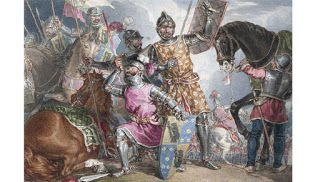 Long live the king, but which king? In March 1461, England had two men that had been named king, and the houses of Lancaster and York went to war (again) over who would reign. Thousands of people died in the Wars of the Roses, but one 10-hour battle was particularly deadly. Now archaeologists have done a post-mortem of a man, believed to have been a mounted knight, who fell in the Battle of Towton, the largest, longest battle on English soil, and have put his skeleton on display in York.
Long live the king, but which king? In March 1461, England had two men that had been named king, and the houses of Lancaster and York went to war (again) over who would reign. Thousands of people died in the Wars of the Roses, but one 10-hour battle was particularly deadly. Now archaeologists have done a post-mortem of a man, believed to have been a mounted knight, who fell in the Battle of Towton, the largest, longest battle on English soil, and have put his skeleton on display in York.
“The skeleton shows some extensive injuries,” Sarah Maltby, director of the York Archaeological Trust, told Culture 24. “He has a stab wound to his left foot, which shattered one of the bones and cut two more. Does this mean he was on horseback and combatants on the ground were slashing at him from below or was this an injury caused by downward blow of a sword? None of his injuries show any evidence of healing, so we can assume all these wounds took place on the battlefield.”
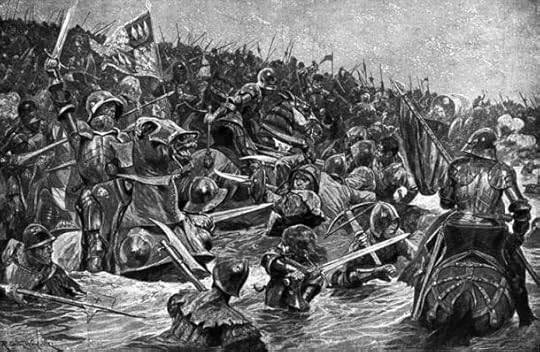 Armored men on horses and on foot attack each other with swords and polearms (
Wikimedia Commons
)But what probably killed him was blunt force to the back of the head, she said. His lower jaw also has a cut mark. Archaeologists speculate the injury to the back of his head came from a war hammer or mace or possibly a sword or poleax if he was wearing a helmet.
Armored men on horses and on foot attack each other with swords and polearms (
Wikimedia Commons
)But what probably killed him was blunt force to the back of the head, she said. His lower jaw also has a cut mark. Archaeologists speculate the injury to the back of his head came from a war hammer or mace or possibly a sword or poleax if he was wearing a helmet.
“It is interesting to note that the cut he has on his jaw matches other individuals found at Towton. Was there a practice of forcibly removing helmets on the battlefield?” Maltby asks.
The man was about 6 feet 1 inch tall and was between 36 and 45. Archaeologists think he had high status in society. His remains have been pieced together by researchers from the Towton Battlefield Archaeology Project and put on display in York's Richard III Experience. His remains were under Towton Hall, apart from the battlefield's mass graves.
Video of a researcher piecing together the fallen knight's skeletonThere was a series of battles to decide whether the house of York or Lancaster would reign. The dispute over succession had been roiling since 1454, when a rival to the Lancastrians, Richard, Duke of York, was named protector of the realm and heir to the throne. He had been named protector because Henry VI had lapsed into insanity.
Henry VI later recovered and rescinded the Act of Settlement that transferred succession to Richard of York and his heirs. Henry VI and his wife, Queen Margaret, wanted the Lancasters in the person of their son to take the throne. The two houses, who had warred already, went to war again over which house would rule. Eventually the Duke of York was ambushed and killed. Nevertheless, his son Edward was proclaimed king, so England then had both King Henry VI of the House of Lancaster and King Edward IV of the House of York.
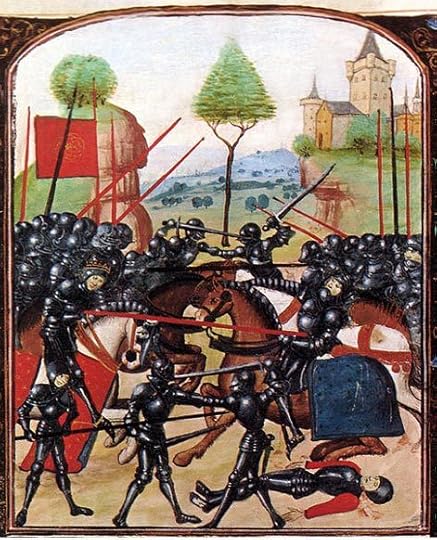 War of the Roses. Illustration of the Battle of Barnet (14 April 1471) on the Ghent manuscript, a late 15th-century document (
Wikimedia Commons
)Edward raised a large army and marched north to establish his monarchy. Medieval claims were that he had 40,000 men, but historians say that is an exaggeration. The Lancasters, though, had an army at least equal to Edward's.
War of the Roses. Illustration of the Battle of Barnet (14 April 1471) on the Ghent manuscript, a late 15th-century document (
Wikimedia Commons
)Edward raised a large army and marched north to establish his monarchy. Medieval claims were that he had 40,000 men, but historians say that is an exaggeration. The Lancasters, though, had an army at least equal to Edward's.
On March 28, 1461, the Yorkists defeated the Lancastrians' vanguard at the river Aire by outflanking them. This set the stage for a Palm Sunday battle in a field between the villages of Towton and Saxton.
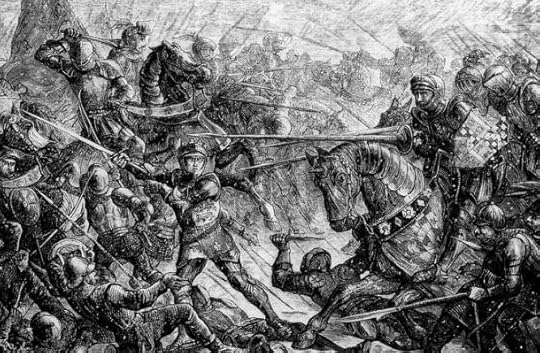 Engraving of Edward IV extolls his troops to fight their Lancastrian foes at the Battle of Towton, 29 March 1461 (
Wikimedia Commons
).The article at the center says it was still an extremely significant battle in political, social and military terms. The Yorkists secured the throne for Edward IV at the Battle of Towton, but Henry, Margaret and their son escaped to Scotland.
Engraving of Edward IV extolls his troops to fight their Lancastrian foes at the Battle of Towton, 29 March 1461 (
Wikimedia Commons
).The article at the center says it was still an extremely significant battle in political, social and military terms. The Yorkists secured the throne for Edward IV at the Battle of Towton, but Henry, Margaret and their son escaped to Scotland.
In 1470 Henry's VI's supporters overthrew Edward and restored Henry to the throne. In 1471 Edward IV came back from exile in the Netherlands, defeated Margaret’s forces, imprisoned Henry and killed their son, the heir apparent. Henry VI was later murdered in the Tower of London. Edward IV ruled until he died in 1483, and his young son was crowned King Edward V.
Enough intrigue? Not quite. Edward IV's brother, Richard the III, imprisoned Edward V and his younger brother in the Tower of London, where they, still children, are believed to have been murdered. Richard III was later killed at the Battle of Bosworth Field at the hands of the Lancastrians under Henry Tudor, who became King Henry VII, the first Tudor King. He married a daughter of Edward IV to unite the houses of York and Lancaster and end the Wars of the Roses.
“The War of Roses left little mark on the common English people but severely thinned the ranks of the English nobility,” says History.com.
Featured image: Three key players in the Battle of Towton, the Earl of Warwick, Edward IV and Richard III are depicted in a painting by John Augustus Atkinson (1775-18833). (Wikimedia Commons)
 Long live the king, but which king? In March 1461, England had two men that had been named king, and the houses of Lancaster and York went to war (again) over who would reign. Thousands of people died in the Wars of the Roses, but one 10-hour battle was particularly deadly. Now archaeologists have done a post-mortem of a man, believed to have been a mounted knight, who fell in the Battle of Towton, the largest, longest battle on English soil, and have put his skeleton on display in York.
Long live the king, but which king? In March 1461, England had two men that had been named king, and the houses of Lancaster and York went to war (again) over who would reign. Thousands of people died in the Wars of the Roses, but one 10-hour battle was particularly deadly. Now archaeologists have done a post-mortem of a man, believed to have been a mounted knight, who fell in the Battle of Towton, the largest, longest battle on English soil, and have put his skeleton on display in York.“The skeleton shows some extensive injuries,” Sarah Maltby, director of the York Archaeological Trust, told Culture 24. “He has a stab wound to his left foot, which shattered one of the bones and cut two more. Does this mean he was on horseback and combatants on the ground were slashing at him from below or was this an injury caused by downward blow of a sword? None of his injuries show any evidence of healing, so we can assume all these wounds took place on the battlefield.”
 Armored men on horses and on foot attack each other with swords and polearms (
Wikimedia Commons
)But what probably killed him was blunt force to the back of the head, she said. His lower jaw also has a cut mark. Archaeologists speculate the injury to the back of his head came from a war hammer or mace or possibly a sword or poleax if he was wearing a helmet.
Armored men on horses and on foot attack each other with swords and polearms (
Wikimedia Commons
)But what probably killed him was blunt force to the back of the head, she said. His lower jaw also has a cut mark. Archaeologists speculate the injury to the back of his head came from a war hammer or mace or possibly a sword or poleax if he was wearing a helmet.“It is interesting to note that the cut he has on his jaw matches other individuals found at Towton. Was there a practice of forcibly removing helmets on the battlefield?” Maltby asks.
The man was about 6 feet 1 inch tall and was between 36 and 45. Archaeologists think he had high status in society. His remains have been pieced together by researchers from the Towton Battlefield Archaeology Project and put on display in York's Richard III Experience. His remains were under Towton Hall, apart from the battlefield's mass graves.
Video of a researcher piecing together the fallen knight's skeletonThere was a series of battles to decide whether the house of York or Lancaster would reign. The dispute over succession had been roiling since 1454, when a rival to the Lancastrians, Richard, Duke of York, was named protector of the realm and heir to the throne. He had been named protector because Henry VI had lapsed into insanity.
Henry VI later recovered and rescinded the Act of Settlement that transferred succession to Richard of York and his heirs. Henry VI and his wife, Queen Margaret, wanted the Lancasters in the person of their son to take the throne. The two houses, who had warred already, went to war again over which house would rule. Eventually the Duke of York was ambushed and killed. Nevertheless, his son Edward was proclaimed king, so England then had both King Henry VI of the House of Lancaster and King Edward IV of the House of York.
 War of the Roses. Illustration of the Battle of Barnet (14 April 1471) on the Ghent manuscript, a late 15th-century document (
Wikimedia Commons
)Edward raised a large army and marched north to establish his monarchy. Medieval claims were that he had 40,000 men, but historians say that is an exaggeration. The Lancasters, though, had an army at least equal to Edward's.
War of the Roses. Illustration of the Battle of Barnet (14 April 1471) on the Ghent manuscript, a late 15th-century document (
Wikimedia Commons
)Edward raised a large army and marched north to establish his monarchy. Medieval claims were that he had 40,000 men, but historians say that is an exaggeration. The Lancasters, though, had an army at least equal to Edward's.On March 28, 1461, the Yorkists defeated the Lancastrians' vanguard at the river Aire by outflanking them. This set the stage for a Palm Sunday battle in a field between the villages of Towton and Saxton.
“It is said that Towton was the largest and longest battle fought on British soil, though it seems likely that, even more than usual, the medieval chronicles grossly exaggerate both the numbers engaged and the casualties incurred at Towton,” says the website UK Battlefields Resource Centre. It was claimed 30,000 men died that day, but modern historians say this is an exaggeration.
 Engraving of Edward IV extolls his troops to fight their Lancastrian foes at the Battle of Towton, 29 March 1461 (
Wikimedia Commons
).The article at the center says it was still an extremely significant battle in political, social and military terms. The Yorkists secured the throne for Edward IV at the Battle of Towton, but Henry, Margaret and their son escaped to Scotland.
Engraving of Edward IV extolls his troops to fight their Lancastrian foes at the Battle of Towton, 29 March 1461 (
Wikimedia Commons
).The article at the center says it was still an extremely significant battle in political, social and military terms. The Yorkists secured the throne for Edward IV at the Battle of Towton, but Henry, Margaret and their son escaped to Scotland.In 1470 Henry's VI's supporters overthrew Edward and restored Henry to the throne. In 1471 Edward IV came back from exile in the Netherlands, defeated Margaret’s forces, imprisoned Henry and killed their son, the heir apparent. Henry VI was later murdered in the Tower of London. Edward IV ruled until he died in 1483, and his young son was crowned King Edward V.
Enough intrigue? Not quite. Edward IV's brother, Richard the III, imprisoned Edward V and his younger brother in the Tower of London, where they, still children, are believed to have been murdered. Richard III was later killed at the Battle of Bosworth Field at the hands of the Lancastrians under Henry Tudor, who became King Henry VII, the first Tudor King. He married a daughter of Edward IV to unite the houses of York and Lancaster and end the Wars of the Roses.
“The War of Roses left little mark on the common English people but severely thinned the ranks of the English nobility,” says History.com.
Featured image: Three key players in the Battle of Towton, the Earl of Warwick, Edward IV and Richard III are depicted in a painting by John Augustus Atkinson (1775-18833). (Wikimedia Commons)
Published on July 10, 2015 07:18
Archaeologists unearth 2,000-year-old Roman Legion outpost that controlled Jewish uprisings
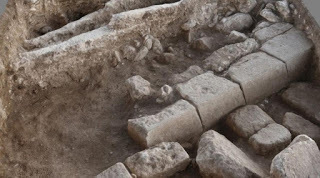 Rome had its hands full in Palestine in the 1st and 2nd centuries AD with two Jewish uprisings against Roman rule. The establishment of a Roman Legion outpost in the Galilee may have prevented the 2nd century revolt from spreading to the north. That Roman camp, the only one of its kind known in the eastern Roman Empire, is now under excavation.
Rome had its hands full in Palestine in the 1st and 2nd centuries AD with two Jewish uprisings against Roman rule. The establishment of a Roman Legion outpost in the Galilee may have prevented the 2nd century revolt from spreading to the north. That Roman camp, the only one of its kind known in the eastern Roman Empire, is now under excavation.The site, called Legio, is near Tel Megiddo in what is now northern Israel. It was the headquarters of the Sixth Legion Ferrata (‘Ironclad’) after the Jewish Revolt of 66-67 AD and probably kept public order during the Bar Kochba Revolt of 132-135 AD in Galilee.
The Times of Israel online reports that Roman rulers stationed two legions in Palestine to keep order, including the one being excavated near Tel Megiddo. The other was in Jerusalem. The location of the permanent military encampment housing the Sixth Legion was unknown until recently, though its name of Legio was memorialized in the name of the nearby Arabic village of Lajjun.
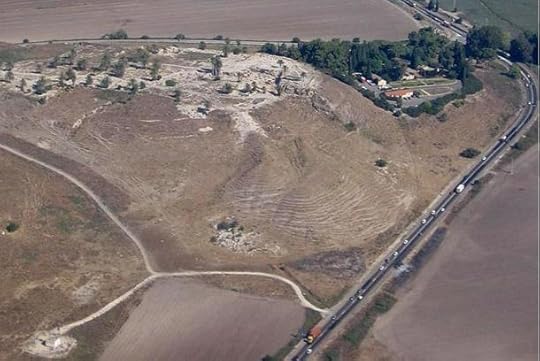 Tell Megiddo, the site of the Roman outpost (
Wikimedia Commons
)In recent years dig co-director Yotam Tepper and his team from the W.F. Albright Institute of Archaeological Research, and the Israel Antiquities Authority did aerial studies and ground surveys in the area that indicated a Roman military structure. In 2013 the team confirmed the presence of the military camp.
Tell Megiddo, the site of the Roman outpost (
Wikimedia Commons
)In recent years dig co-director Yotam Tepper and his team from the W.F. Albright Institute of Archaeological Research, and the Israel Antiquities Authority did aerial studies and ground surveys in the area that indicated a Roman military structure. In 2013 the team confirmed the presence of the military camp.“We’re talking about a large camp, an imperial camp, one of about 5,000 soldiers, about 300 meters by 500 meters (984 feet by 1,640 feet),” Tepper told The Times. “These are things we wouldn’t have been able to say [about the site] two years ago.”
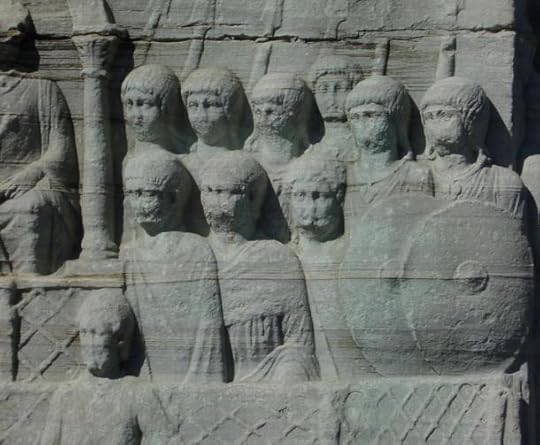 Ancient carving of Roman soldiers on the base of Theodosius I's obelisk in Constantinople (c. 390). The troops belong to a regiment of palatini as they are here detailed to guard the emperor (
Wikimedia Commons
)So far this season archaeologists have excavated a large building that may have been the commander's residence, ceramic roofing tiles with the legion's mark, sewer channels with clay pipes and several buildings. All the construction points to a deliberate, carefully planned outpost.
Ancient carving of Roman soldiers on the base of Theodosius I's obelisk in Constantinople (c. 390). The troops belong to a regiment of palatini as they are here detailed to guard the emperor (
Wikimedia Commons
)So far this season archaeologists have excavated a large building that may have been the commander's residence, ceramic roofing tiles with the legion's mark, sewer channels with clay pipes and several buildings. All the construction points to a deliberate, carefully planned outpost.Though other Roman encampments have been found in the Eastern Empire, all so far, such as the siege camp at Masada in Israel, had been temporary Roman outposts.
Matthew J. Adams of the Albright Institute and co-director of the dig said, “Our entire understanding about Roman military architecture, and especially Roman legionary bases for this particular period… comes from the western empire — Germany, Britain and Gaul.”
The Romans had a situation on their hands in the first century AD with what Adams called an “unruly population” that took four years to control after the uprising began. The Roman military camp was at the strategic crossroads of Tel Megiddo that connected the Sea of Galilee and Damascus to the main highway and coastal road. “Control of the Galilee can very much be had from this particular location, as it had been for centuries, that’s why Tel Megiddo is here from the Bronze Age onwards,” Adams said.
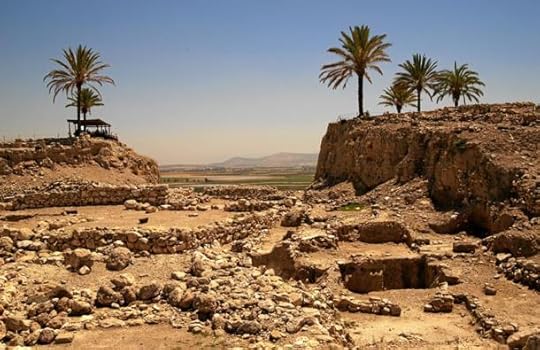 The ruins of Tel Megiddo (
Wikimedia Commons
)“In the aftermath of the first revolt, you had the beginnings of a lot of emigration of the Jewish population of Judea northward,” Adams told The Times. “The Galilee was increasingly the center of Jewish activity. Probably one of the reasons that they brought the legion here at all was to garrison this unruly population.”
The ruins of Tel Megiddo (
Wikimedia Commons
)“In the aftermath of the first revolt, you had the beginnings of a lot of emigration of the Jewish population of Judea northward,” Adams told The Times. “The Galilee was increasingly the center of Jewish activity. Probably one of the reasons that they brought the legion here at all was to garrison this unruly population.”The fort may also have been an outpost for construction of Roman infrastructure, including aqueducts and roads in the 2nd and 3rd centuries AD. There were plentiful sources of water in the area, another strategic consideration.
It is probably no accident that the first Jewish Revolt against Roman rule was fought in the Galilee and farther south in Judea, Adams said, while the later Bar Kochba Revolt was not fought much in the vicinity of Legio but rather more south, near Jerusalem.
“Considering the fact that the first revolt had a lot of its origins in the northern half of the country, it’s surprising that during the Bar Kochba Revolt the Galilee did not seem to be involved. And that’s probably because the Roman legion was here,” he said. “This is the first time we had the opportunity to understand how the Roman military was organized, in terms of their settlement especially, in the eastern empire.”
In a statement to The Times of Israel, the archaeological team said the excavations at Legio have helped bring a better understanding of Roman military engineering and architecture. They called the finds “rare and unique in the Roman East.”
Featured image: The remnants of a Roman street in Legio, a permanent Roman military outpost in Palestine (Photo by Jezreel Valley Regional Project)
Ancient Origins
Published on July 10, 2015 07:10
History Trivia - City of Dublin founded
July 10
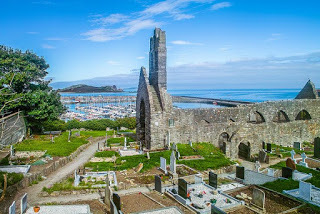
988 The city of Dublin was founded on the banks of the river Liffey.
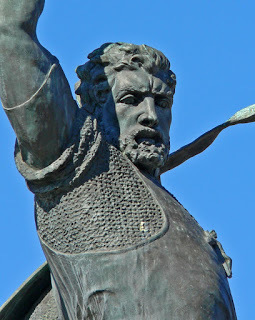
1099 El Cid, of Castile died.
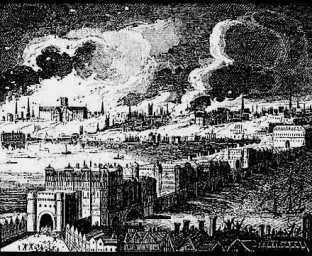
1212 The most severe of several early fires of London burned most of the city to the ground.

988 The city of Dublin was founded on the banks of the river Liffey.

1099 El Cid, of Castile died.

1212 The most severe of several early fires of London burned most of the city to the ground.
Published on July 10, 2015 01:30
July 9, 2015
History Trivia - Hadrian enters Rome
July 9
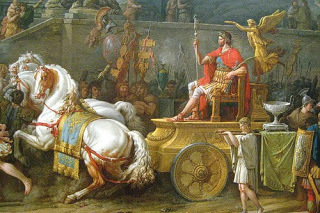
118 Hadrian, Rome's new emperor, made his entry into the city.
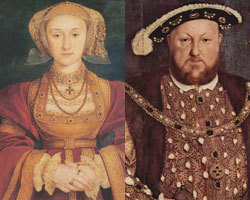
1540 King Henry VIII of England annulled his marriage to his fourth wife, Anne of Cleves.
1553 La dy Jane Grey was proclaimed queen of England in succession to Edward VI, who died three days earlier. Her reign lasted nine days since Mary Tudor (daughter of Henry VIII and Catherine of Aragon) claimed the right of succession.
dy Jane Grey was proclaimed queen of England in succession to Edward VI, who died three days earlier. Her reign lasted nine days since Mary Tudor (daughter of Henry VIII and Catherine of Aragon) claimed the right of succession.

118 Hadrian, Rome's new emperor, made his entry into the city.

1540 King Henry VIII of England annulled his marriage to his fourth wife, Anne of Cleves.
1553 La
 dy Jane Grey was proclaimed queen of England in succession to Edward VI, who died three days earlier. Her reign lasted nine days since Mary Tudor (daughter of Henry VIII and Catherine of Aragon) claimed the right of succession.
dy Jane Grey was proclaimed queen of England in succession to Edward VI, who died three days earlier. Her reign lasted nine days since Mary Tudor (daughter of Henry VIII and Catherine of Aragon) claimed the right of succession.
Published on July 09, 2015 01:30
July 8, 2015
What was the werewolf myth in Ancient Rome?
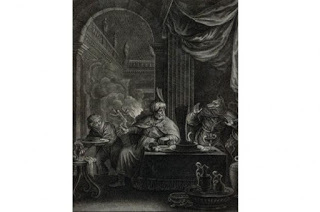
King Lycaon is transformed into a wolf. © Mary Evans Picture Library / Alamy
Dr Miles Russell investigates...
It’s difficult to say precisely when the story of the werewolf first developed. The twins Romulus and Remus had been suckled by a she-wolf, and so the idea of the human/wolf hybrid was ingrained in the Roman psyche from an early date.
Shape shifters were quite common in Greek and Roman mythology – the metamorphosis from human to animal form often occurred as a direct result of divine punishment; the gods condemning an individual on the basis of pride, boastfulness or blasphemy.
Pliny the elder described the lycanthropic shape shifting of a man into a wolf by the gods following an act of cannibalism. Early in the 1st century AD, the Roman poet Ovid wrote Metamorphoses in which King Lycaon (from whom we get the term ‘Lycanthrope’) offended the gods by serving them human flesh. His punishment was being transformed into a wolf so he could continue his disgusting eating habits.
Dr Miles Russell is a senior lecturer in prehistoric and Roman archaeology, with more than 25 years experience of archaeological fieldwork and publication.
For more burning historical Q&As on the Tudors, ancient Rome, the First World War and ancient Egypt, click here.
History Extra
Published on July 08, 2015 05:29
History Trivia - city of Paris, France founded by the Parisii
July 8
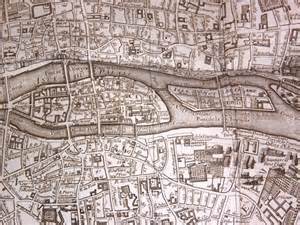
49 BC, the city of Paris, France was founded by the Parisii, a Celtic tribe of fishermen.
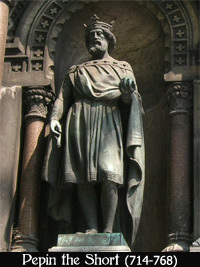
810 Pepin, son of Charlemagne, King of Italy, died.
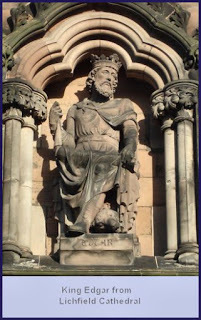
975 Edgar, considered the first King of a united England, reigning over Mercia, Northumbria and Wessex, died.

49 BC, the city of Paris, France was founded by the Parisii, a Celtic tribe of fishermen.

810 Pepin, son of Charlemagne, King of Italy, died.

975 Edgar, considered the first King of a united England, reigning over Mercia, Northumbria and Wessex, died.
Published on July 08, 2015 01:00
July 7, 2015
History Trivia - Julius Caesar invades Britain
July 7
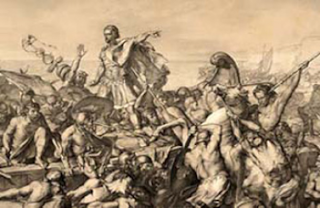
54 BC Julius Caesar's second invasion of Britain begins as he lands his troops, probably near Deal, Kent.

1550 Chocolate was introduced.
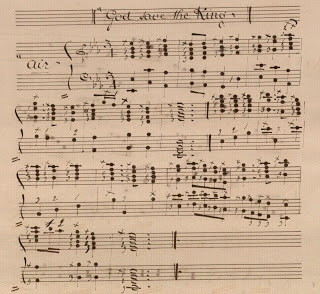
1607 “God Save the King" was sung for the first time.

54 BC Julius Caesar's second invasion of Britain begins as he lands his troops, probably near Deal, Kent.

1550 Chocolate was introduced.

1607 “God Save the King" was sung for the first time.
Published on July 07, 2015 02:00
July 6, 2015
The Diane Turner Show now playing on Mixcloud
Published on July 06, 2015 14:00
5 facts about… Alfred the Great
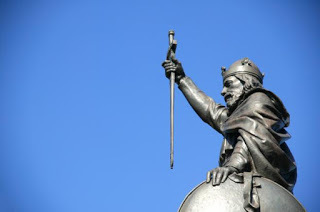 History Extra
History ExtraThe recent discovery of a piece of pelvic bone thought to belong to King Alfred, or to his eldest son, Edward, has sparked new interest in the King of Wessex
Alfred the Great statue in Winchester © Anthony Baggett | Dreamstime.com
The archaeological find has even been compared to the discovery of Richard III's remains, with archaeologist Neil Oliver claiming it, "overshadowed" it.
Here, we bring you five fun facts about the King Alfred:
1) Alfred the Great is best remembered for his victories against the Vikings. Without him there would probably be no England, and no English language!
2) Legend has it that, while hiding from the Vikings in a cowherd’s hut on a marshy island in Somerset, Alfred was scolded by the man’s wife for letting her loaves (or ‘cakes’) burn.
3) Alfred is the only English monarch to be known as ‘the Great’.
4) The story goes that Alfred once disguised himself as a minstrel (or singer) to sneak into a Viking camp to spy on them. Armed with his harp, he dazzled the Danes with tunes he had learnt as boy, and stayed at the camp for several days.
5) It’s believed that Alfred suffered from what we now know as Crohn's disease – a type of inflammatory bowel disease that causes abdominal pain, diarrhoea, weight loss and fatigue.
Published on July 06, 2015 06:54
Tewkesbury Medieval Festival - July 11 and 12, 2015
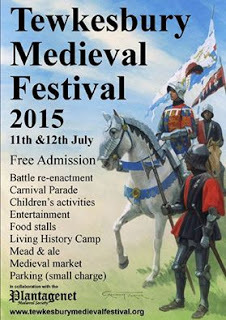 Tewkesbury
TewkesburyThis years event:11th and 12th July 2015Opening Hours: Saturday 11am-6pm Sunday 11am-5pmBattle reenactment 4pm Sat, 3pm Sun New for this year: A Medieval carnival style parade,Sunday 12th, 11am from Tewkesbury High Street to the Festival. Contact us for more details All the latest updates are on Facebook. Armour At The Abbey will take place on the 2nd,3rd 4th May
On the 11th & 12th of July thousands of reenactors, entertainers and traders from all over Europe will gather in Tewkesbury for Europes largest annual Medieval reenactment. A fantastic and unique day out for all the family, with free admission.------------------------------Where to stay for the Festival.Coming to the Festival? Unsure where to stay? Book now, Tewkesbury accommodation gets full...Support the event by booking into our own campsite, 3 minutes away from the main site.A relaxed campsite with good loos and hot showers included.
£20 per person for the two nights, £10 extra for motorhomes/campers
Book though Tewkesbury Tourist Infomation:
Tel 01684 855040
www.outofthehat.org.uk
Published on July 06, 2015 06:48




